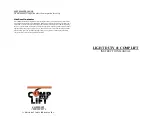
Outlander Vehicle Lifts:
Installation & Service Manual
27DEC19 | 630-00133 REV A
8
OUTLANDER VEHICLE LIFTS:
SECTION 3
PREPARATION
VEHICLE HITCH
1.
The Outside Vehicle Lift requires a vehicle that
accepts a Class 2 or 3 hitch. Check to ensure
that the vehicle is wired using a standard four-
connector trailer style of wiring.
2.
If you are unsure of the vehicle and hitch
capability, contact a local installer who is
reputable, insured and competent. The installer’s
performance affects the customer’s perception
of your mobility lift installation.
NOTE: Hitch installation is not possible on every vehicle.
3.
Add the combined weights of the lift, mobility
device and, where applicable, the swing-away
option. Ensure that the total weight does not
exceed the hitch’s recommended tongue weight.
Many hitches are available on the market, and
all are designed to bear a specific amount of
weight. See Figure 3-1.
The installer must adhere to the vehicle’s Gross
Vehicle Weight Rating restrictions.
Understand that some states have strict license
plate obstruction laws. Acquaint yourself with
local and state laws.
4.
The receiver tube of the hitch must be installed
parallel to the ground. This is a requirement
and not a recommendation, as an improperly
installed hitch affects the operation of the lift.
Note that some vehicles require the rear
suspension to be supplemented. If the vehicle
has suspension requirements, the installer
should contact a suspension specialist for
additional technical support.
Figure 3-1
lb
CHAIR/
SCOOTER
IF
USED
MEC153522
41 lb
120-00357C
" x " lb
8 lb
TM: SSEL1008 ______ 2 or 3 _______TBD lb
DE: SSEL1009_______ 2 or 3 _______80 lb
XL: SSEL1010 _______ 2 or 3 _______TBD lb
Full: SSEL1011 ______ 2 or 3 _______TBD lb
OR
OR
PRODUCT:
HITCH
CLASS:
WEIGHT:









































